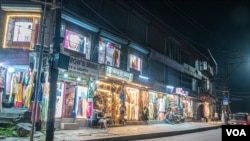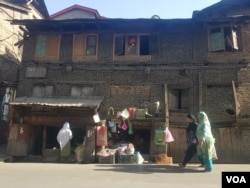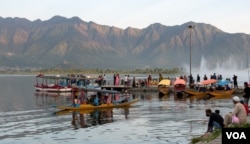Tourists are returning to the Kashmir Valley in record numbers, three years after the massive security lockdown that accompanied the revocation by New Delhi of the region’s special status. But other sectors of the economy still are struggling, and security remains a concern.
The economic life of India-administered Kashmir was stifled when India’s parliament abruptly moved on August 5, 2019, to remove the region’s political autonomy. Seeking to forestall a violent reaction, the federal government shut down the internet and other forms of communication for months and flooded security forces into what is now ruled as the union territory of Jammu and Kashmir.
Tourism to the valley, renowned worldwide for its scenic mountains and lakes, collapsed along with the general economy, and was slow to recover. Official figures show that just over 41,000 people visited Kashmir in all of 2020.
But the industry has rebounded spectacularly in recent months, with up to 10,000 people — mostly from other parts of India — arriving on some 100 flights a day to the airport in Srinagar. The federal government reported 10.6 million tourist visits in the first six months of this year.
Authorities attribute the surge in part to the coronavirus pandemic, which has made foreign travel more difficult.
“People who would otherwise go to Europe and other countries preferred to come to Kashmir [while] restrictions were in force on international travel,” G.N. Itoo, director of Tourism Kashmir, said in an interview in April with VOA.
“Secondly we created good experiences like [the] houseboat festival, Sufi festival, winter carnival and many more, which created a buzz,” Itoo said.
International businesses are also beginning to reconsider Kashmir. Delegates representing 33 companies from the United Arab Emirates, Hong Kong and Saudi Arabia attended a conference in Srinagar in March where investments totaling $380 million were promised.
Responding to a question in the upper house of parliament in New Delhi, Rakesh Sinha, a professor and member of parliament, said Jammu and Kashmir has received investment applications totaling $6.7 billion and that industrial land has been allotted for projects valued at $4.5 billion.
‘Political coma’
But while the regional government has signed memoranda of understanding with several companies, none of that investment has yet materialized.
“I haven’t come across any company that would have either started their operations or implemented any project in the Kashmir Valley,” Tariq Rashid Ghani, president of the Chamber of Commerce and Industry Kashmir, told VOA.
Manoj Joshi, a fellow at the Observer Research Foundation in New Delhi, also remains skeptical.
“I don't expect much foreign investments coming in. In fact, to the best of my knowledge, there is not too much Indian private investment coming in, either,” he told VOA.
“The valley is in a state of political coma. It is sufficiently disturbed to prevent any private investor from taking the risk of investing north of the Banihal Pass,” which marks the entrance to the Kashmir Valley.
Ghani said the flood of tourists has done little to lift other sectors of the economy, in large part because of heavy debts incurred as a result of the back-to-back lockdowns —first over the revocation in 2019 and then over the pandemic.
“There was huge liability on traders associated with tourism, and [they] had to repay loans. We had time and again appealed to the government for the interest waiver or restructuring of the loans, but that never happened,” Ghani lamented.
Other economic hurdles include the worldwide surge of inflation, which has not spared Kashmir. The central government’s National Statistical Office reported a 7.2% inflation rate for the region in June, slightly higher than the 7.01 rate recorded for the country as a whole.
And unemployment remains stubbornly high. The Center for Monitoring Indian Economy, an independent think tank, calculated the region’s unemployment rate in July at 20.2% the second highest of any state or union territory in India.
Nisar Ali, a Kashmir-based economist, told VOA he believes it may be a couple of years before the benefits of the government’s efforts to attract investment to the valley will be felt on the ground.
Problems with internet connectivity have also been a drag on economic recovery. According to the Software Freedom Law Center, an online legal services organization, the Kashmir Valley has had 287 internet cuts in the last five years, with 116 in 2020 alone. The longest, which coincided with the revocation of autonomy in 2019, lasted for 552 days.
Political unrest stemming from the revocation also persists.
The Jammu Kashmir National Conference party reported that its president, Farooq Abdullah, was briefly placed under house arrest after attending a meeting on August 5 where he was quoted as saying the 2019 revocation “marks [a] breach of trust” and is “not acceptable to us."
A police spokesman called the allegations of Abdullah’s house arrest “completely baseless” and “fake news.”
The revocation was also protested by members of the Jammu and Kashmir Peoples Democratic Party, whose president, Mehbooba Mufti, marked the August 5 anniversary with a tweet saying India’s ruling Bharatiya Janata Party’s “malicious designs for J&K have unraveled” and that “the pattern of suppression & fear is now knocking at the door in rest of the country too.”
The low-level insurgency that has long kept Kashmiris on edge has continued, although at a reduced pace since the revocation, with 174 security forces and 110 civilians killed in incidents related to militancy since August 5, 2019, according to police. That is down from 290 security forces and 191 civilian deaths in the previous three years.
According to the South Asian Terrorism Portal, a database tracking terrorism and low-intensity warfare in South Asia, three security forces and three individuals identified as terrorists were killed in July, the lowest number for any month of this year.
However, three soldiers and two attackers were reported killed Thursday in a militant attack on an Indian army post ahead of India’s Independence Day celebrations.









